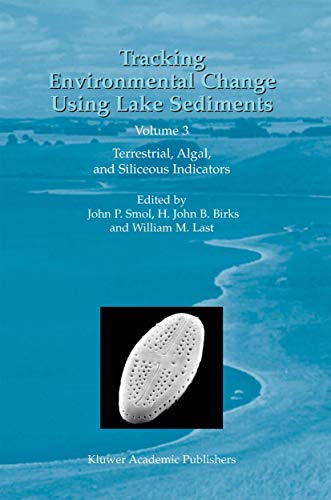Tracking Environmental Change Using Lake Sediments: Volume 3: Terrestrial, Algal, and Siliceous Indicators (Developments in Paleoenvironmental Research, Band 3) - Softcover
Buch 1 von 15: Developments in Paleoenvironmental Research
Inhaltsangabe
This third volume in the Developments in Paleoenvironmental Research series deals with the major terrestrial, algal, and siliceous indicators used in paleolimnology. Other volumes deal with the acquisition and archiving of lake sediment cores, chronological techniques, and large-scale basin analysis methods (Volume 1), physical and geochemical parameters and methods (Volume 2), zoological techniques (Volume 4), and statistical and data handling methods (Volume 5). These monographs will provide sufficient detail and breadth to be useful handbooks for both seasoned practitioners as well as newcomers to the area of paleolimnology. Although the chapters in these volumes target mainly lacustrine settings, many of the techniques described can also be readily applied to fluvial, glacial, marine, estuarine, and peatland environments.
Die Inhaltsangabe kann sich auf eine andere Ausgabe dieses Titels beziehen.
Über die Autorin bzw. den Autor
John P. Smol is a professor in the Biology Department at Queen's University (Canada), with a cross-appointment at the School of Environmental Studies. He co-directs the Paleoecological Environmental Assessment and Research Lab (PEARL). Professor Smol is co-editor of the Journal of Paleolimnology and holds the Canada Research Chair in Environmental Change. William M. Last is a professor in the Department of Geological Sciences at University of Manitoba (Canada) and is co-editor of the Journal of Paleolimnology.
„Über diesen Titel“ kann sich auf eine andere Ausgabe dieses Titels beziehen.
Weitere beliebte Ausgaben desselben Titels
Suchergebnisse für Tracking Environmental Change Using Lake Sediments:...
Tracking Environmental Change Using Lake Sediments : Volume 3: Terrestrial, Algal, and Siliceous Indicators
Anbieter: AHA-BUCH GmbH, Einbeck, Deutschland
Taschenbuch. Zustand: Neu. Druck auf Anfrage Neuware - Printed after ordering - Biology Distribution and ecology Taphonomy and preservation Field sampling and coring Laboratory procedures Data analysis and interpretation Summary Acknowledgements References 9. Chrysophyte scales and cysts. B. A. Zeeb & J. P. Smol 203 Introduction Taxonomy and nomenclature Methods Paleolimnological applications Future research directions Summary Acknowledgements References 10. Ebridians. A. Korhola & J. P. Smol 225 Introduction Morphology, taxonomy and preservation in the sediments Methodological aspects Brief history of use of ebridians in palaeoecological research Indicator value and future research priorities Summary Acknowledgements References 11. Phytoliths. D. R. Piperno 235 Introduction and history Phytolith production and taxonomy Laboratory methods Applications of phytolith analysis in lake sediments Summary of the major results Other potential applications of phytoliths in lake sediments Summary Acknowledgments References x 12. Freshwater sponges. 253 T. M. Frost Introduction Sponge species and their distribution Sponge life history Sponge spicules Paleolimnological studies using freshwater sponges Techniques for assessing sponge spicules in sediments Future applications of sponges in paleolimnology Summary Acknowledgements References 13. Siliceous protozoan plates and scales. M. S. V. Douglas & J. P. Smol 265 Introduction History and taxonomy Ecology Paleoecological potential Laboratory methods Data presentation Paleolimnological applications Other related siliceous indicators Summary Acknowledgements References 14. Biogenic silica. D.J. Conley & C.L Schelske 281 Introduction and history Methods Applications Future directions Summary Acknowledgements References 15. Sedimentary pigments. Artikel-Nr. 9789048160488
Neu kaufen
Versand von Deutschland nach USA
Anzahl: 1 verfügbar
Tracking Environmental Change Using Lake Sediments: Volume 3: Terrestrial, Algal, and Siliceous Indicators (Developments in Paleoenvironmental Research)
Anbieter: Revaluation Books, Exeter, Vereinigtes Königreich
Paperback. Zustand: Brand New. 2001 edition. 400 pages. 9.37x6.30x0.94 inches. In Stock. Artikel-Nr. x-9048160480
Neu kaufen
Versand von Vereinigtes Königreich nach USA
Anzahl: 2 verfügbar
Tracking Environmental Change Using Lake Sediments
Anbieter: Kennys Bookstore, Olney, MD, USA
Zustand: New. Editor(s): Smol, John P.; Birks, H. John B.; Last, William M. Series: Developments in Paleoenvironmental Research. Num Pages: 396 pages, biography. BIC Classification: PNN; PSA; RBGB; RBGK; RBK; RBX. Category: (P) Professional & Vocational. Dimension: 235 x 155 x 20. Weight in Grams: 559. . 2010. 1st ed. Softcover of orig. ed. 2001. Paperback. . . . . Books ship from the US and Ireland. Artikel-Nr. V9789048160488
Neu kaufen
Versand innerhalb von USA
Anzahl: 15 verfügbar

